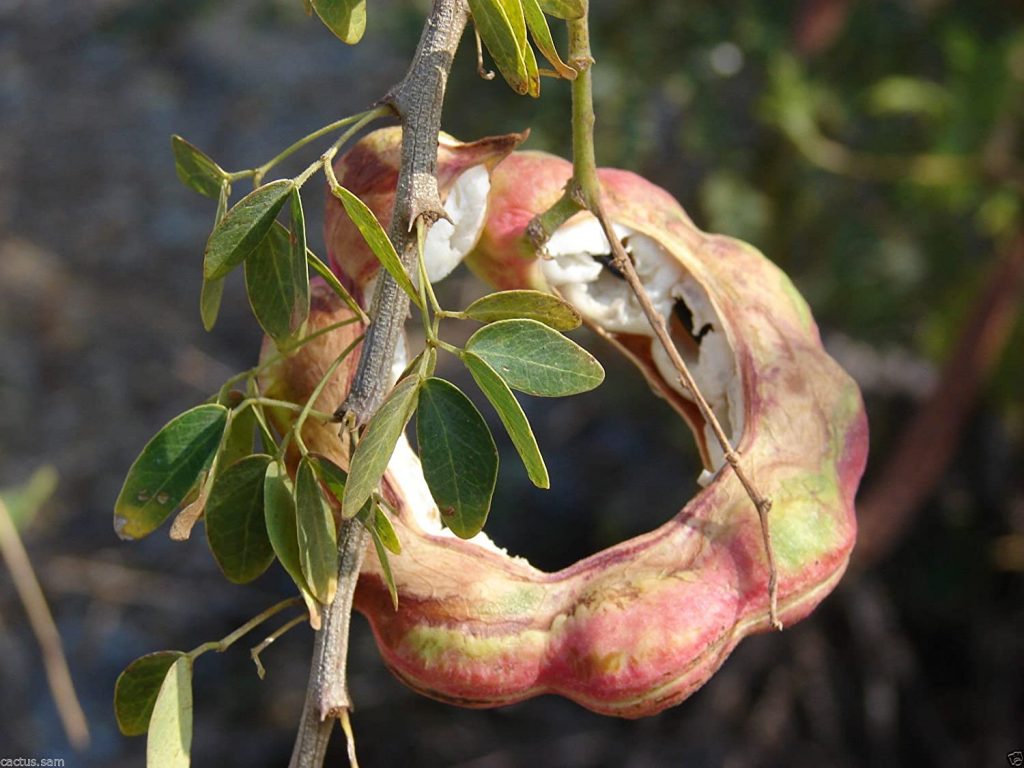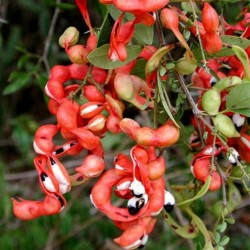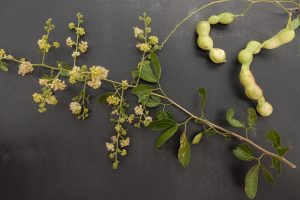
Camachili is closely relayed to the “Texas Ebony.”
Camachile, Guamuchil
Pithecellobium dulce
I was teaching in an eclectic park one day when the visiting aunt of a student recognized a tree from back home on the other side of the world. She knew it as camachile which is actually a native of Mexico where it is known as guamuchil.
This huge, thorny tree has a multitude of names and is in the same genus as Texas Ebony. And like the Texas Ebony it has edible fruit. The most commonly consumed part is the aril around the seed. Livestock like the fruit and leaves.

The arils is commonly eaten.
The aril, which is 60% of the pod, contains per 100 grams 78 calories, 3.0% protein, 0.4% fat, 18.2% total carbohydrate, and 1.2% fiber. It has 13 mg of calcium, 42 mg phosphorus, 0.5 mg iron, 19 mg sodium, 222 mg potassium, 15 mg beta-carotene equivalent, 0.24 mg B1 (thiamin) 0.10 mg B2 (riboflavin) 0.60 mg B3 (niacin) and 133 mg ascorbic acid more than twice your daily need. The essential amino acids are 143 mg of valine per 100 grams, 178 lysine, 41 phenylalanine, and 26 tryptophan.
Per 100 grams of seeds it has 17.7 grams protein, 17.1 grams fat, 41.4 grams starch, and 7.8 grams fiber. On alcoholic extraction, the seeds yield a saponin, a sterol glucoside, a flavone, and lecithin. The fatty acid composition of the seed is 24.3% saturated acids, 51.1% oleic, and 24.0% linoleic. Another analysis shows 0.3% caprylic acid, 0.3% caprinic, 0.3% lauric, 0.8% myristic, 12.1% palmitic, 6.9% stearic, 3.1% arachidic, 13.1% behenic, 4.9% lignoceric, 32.2% oleic, and 26.0% linoleic.
The tree is not only native to Mexico but is found through Central America to Colombia and Venezuela. Introduced into southern Florida, Cuba, Jamaica, Puerto Rico, and St. Croix. It’s an invasive weed in Hawaii.

Everything starts green.
Pithecellobium means Monkey’s Earring, dulce is sweet. Guamuchil is from the Nahauti name cuauhmochitl. It is related to P. lobatum, (lobes) which has several edible parts as well. According to Cornucopia II from page 153, P. lobatum “seeds are eaten raw, boiled, salted or cooked with coconut milk or oil. Young leaves, flowers and fruits are eaten. A delicacy called amping is made by pounding the cotyledons one by one in the shape of cakes which are sun dried. The emping is fried in coconut oil, sprinkled with salt, and eaten at the rice table. Seeds are a source of a starch.”
Green Deane’s Itemize Plant Profile
IDENTIFICATION: A large, almost evergreen tree that grows up to sixty feet or more in height, it has a broad crown (to thirty feet across) and a thick truck (more than a yard through.) At the base of each leaf is normally found a pair of short, sharp spines. Reproduces easily from seeds or cutting, used for hedges, grows quickly. Makes a lot of smoke when burned. Not a good nitrogen fixer.
TIME OF YEAR: Flowers in your dry season.
ENVIRONMENT: Tolerant of drought, heat, poor soil, salt, sand and shade.
METHOD OF PREPARATION: The aril is edible raw or cooked, the high-protein seeds are eaten raw or often mixed with curry and have an edible green oil. Fruit is made into a drink.

